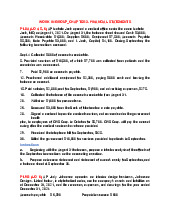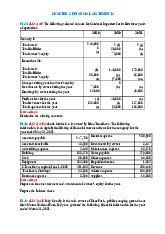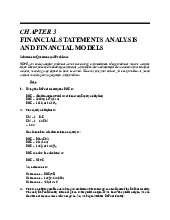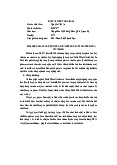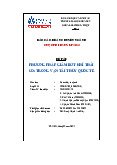







Preview text:
MIDTERM TEST- FINANCIAL MANAGEMENT - 2233 Student name: Student ID: Major: Phone number: Duration: 60’ Please noti e
c that you can choose 30 out of 60 questions. 1. A stakeholder is:
A) A person who owns shares of stock.
B) Any person who has voting rights based on stock ownership of a corporation.
C) Any person or entity other than a stockholder or creditor who potentially has a
claim on the cash flows of a firm.
D) A person who initially founded a firm and currently has management control over that firm. Answer: C
2. If a firm has a degree of financial leverage DOL of 5, this tell us that:
A) If EBIT rise by 5%, EPS will rise by 5%.
B) If EBIT rise by 1%, EPS will rise by 1%.
C) If EBIT rise by 5%, EPS will fall by 25%.
D) If EBIT rise by 1%, EPS will rise by 5%. Answer: D
3. Shareholder A sold 500 shares of ABC stock on the Hochiminh Exchange. This transaction:
A) Took place in the primary market.
B) Took place in the secondary market
C) Took place in the monetary market D) ALL Answer: B
4. A long-term debt instrument by which a borrower of funds agrees to pay back the
funds (principal) with interest on specific dates in the future A) Stock B) Bond C) Par value D) Coupon Answer: B
5. Which one of the following business types is best suited to raising large amounts of capital? A) Sole proprietorship B) Corporation C) Limited liability company D) General partnership Answer: B
6. What are the distributions to shareholders by a corporation called? A) Retained earnings B) Dividends C) Net income D) Capital gain/loss Answer: B
7. Who is the owner of a corporation A) Stakeholders B) Stockholders C) Bondholders 1 D) Managers Answer: B
8. Agency problem of equity is related to A) Bondholders and managers B) Shareholders and managers
C) Shareholders and bondholders
D) Shareholders and stakeholders Answer: B 9. The goal of a firm is A) Minimize costs B) Maximize profit C) Maximize firm value D) Maximize competition Answer: C
10. Dividend is calculated based on A) EBIT B) EBT C) EAT Answer: D
11. Capital structure is related to A) Capital budgeting decision B) Investment decision C) Working capital decision D) Financing decision Answer: D
12. You are considering investing in a stock that sells for $250, what is $250? A) Book value B) Market value C) Liquidation value Answer: B
13. Working capital decision is related to A) Daily activities
B) Transaction of stocks on stock market C) Long-term activities D) Bond issue Answer: A
14. In finance, "Net working capital" means the same thing as A) Total assets B) Fixed assets C) Current assets
D) Current assets minus current liabilities Answer: D
15. In deciding the appropriate level of current assets for the firm, management is confronted with
A) A trade-off between profitability and liquidity
B) A trade-off between liquidity and risk
C) A trade-off between equity and debt
D) A trade-off between short-term versus long-term borrowing Answer: A
16. ……. varies inversely with profitability A) Liquidity B) Risk C) Firm value 2 Answer: A
17. In principal, financing current assets includes A) Accounts receivable B) Accounts payable C) Short-term loans D) B&C Answer: D
18. In nature, permanent working capital is A) Short-term
B) Financed by short-term sources of fund C) Long-term D) A&B Answer: C
19) In nature, temporary working capital is A) Short-term
B) Financed by short-term sources of fund C) Long-term D) A&B Answer: D
20) A company can lower financial leverage by doing which of the following? A) Borrow more
B) Shift short-term to long-term debt
C) Shift long-term to short-term debt D) Sell stock Answer: D 21) Trade credit
A) Reflect in accounts receivable B) Short-term
C) Credit based on goods or services D) ALL Answer: D 22)Net working capital A) Negative B) Short-term
C) Financed by short-term sources of fund D) ALL Answer: D
23. A firm's degree of operating leverage (DOL) depends primarily upon its A) Sales variability B) EBIT variability C) Unit sold variability D) B&C Answer: D
24. EBIT is usually the same thing as:
A) Funds provided by operations B) Earnings before taxes C) Net income D) Operating profit Answer: D
25. If a firm has a degree of operating leverage DOL of 5 at Q units, this tell us that:
A) If sales rise by 5%, EBIT will rise by 5%
B) If sales rise by 1%, EBIT will rise by 1%
C) If sales rise by 5%, EBIT will fall by 25% 3
D) If sales rise by 1%, EBIT will rise by 5% Answer: D
26. A firm's degree of total leverage (DTL) is equal to its degree of operating leverage
its degree of financial leverage (DFL) A) Plus B) Minus C) Divided by D) Multiplied by Answer: D
27. The term "capital structure" refers to:
A) Long-term debt, preferred stock, and common stock equity
B) Current assets and current liabilities
C) Total assets minus liabilities D) Shareholders' equity Answer: A 28. Investment is the
A) Net additions made to the nation’s capital stocks
B) Person’s commitment to buy a flat or house
C) Employment of funds on assets to earn returns
D) Employment of funds on goods and services that are used in production process Answer: C
29. Financial management is mainly concerned with
A) All aspects of acquiring and utilizing financial resources for firms activities B) Arrangement of funds
C) Efficient Management of every business D) Profit maximization Answer: A
30. Market value of the shares is decided by A) The respective companies B) The market participants C) The government D) Shareholders Answer: B
31. Financial leverage measures
A) Sensitivity of EBIT with respect of % change with respect to output
B) % variation in the level of production
C) Sensitivity of EPS with respect to % change in level of EBIT
D. No change with EBIT and EPS Answer: C
32. ……. are financial assets A) Bonds B) Machines C) Stocks D) A and C Answer: D
33. Cost of retained earnings is equal to A) Cost of equity B) Cost of debt C) Cost of bank loan D) A &C Answer: A 34. Variable cost per unit
A) Varies with the level of output 4
B) Remains constant irrespective of the level of output
C) Changes with the growth of the firm
D) Does not change with volume of production Answer: A
35. Marketable securities are primarily
A) Short-term debt instruments
B) Short-term equity securities C) Long-term debt instruments
D) Long-term equity securities Answer: A
36. An increase of current assets and an decrease of current liabilities are a
A) Change in net working capital B) Change in current assets
C) Change in current liabilities D) Change in depreciation Answer: A
37.__________ is concerned with the maximization of a firm's earnings after taxes
A) Shareholder wealth maximization B) Profit maximization C) Stakeholder maximization D) EPS maximization Answer: B
38._______________ is the most appropriate goal of the firm
A) Shareholder wealth maximization B) Profit maximization C) Stakeholder maximization D) EPS maximization Answer: C
39. The __________ decision involves a determination of the total amount of assets
needed, the composition of the assets, and whether any assets need to be reduced, eliminated, or replaced A) Capital structure B) Working capital C) Investment D) All Answer:C
40. __________ is the employment of an asset is sources of fund for which the firm has to
pay a fixed cost or fixed return A) Asset management B) Profit maximization C) Operating leverage D) Financial leverage Answer: C
41. ___________________ refers to make-up of a firm's capitalization A) Capital structure B) Capital budgeting C) Investment D) Dividend policy Answer: A
42. Financial leverage refers to the rate of change in earnings per share for a given
change in earnings__________________ A. Before tax 5 B. Before interest C. Before interest and tax D. After interest and tax Answer: C
43. The mix of debt and equity in a firm is referred to as the firm's _______ A. Capital allocation B. Capital raising C . Cost of capital D. Capital structure Answer: D 44. Retained earnings are A) Long-term B) For reinvestment
C) Listed on the right hand-side of the balance sheet D) ALL Answer: D
45. Items in current assets are listed based on A) Term B) Liquidity C) Value D) All Answer: B
46. In principle, current asset can be financed by A) Accounts payable B) Accounts receivable C) Equity D) Long-term debt Answer: A
47. Agency theory examines the:
A) Relationship between the owners and managers of the firm
B) Insurability of the firm's assets
C) Relationship between dividend policy and firm value
D) Value of the firm relative to other firms in the industry Answer: A
48. The increase in retained earnings is derived:
A) Earnings before taxes - taxes
B) Earnings after-taxes - dividends C) Operating profit - taxes
C) Operating profit – dividends Answer: B
49. The income statement measures:
A) What the firm owns and how those assets are financed
B) The profitability of the firm at a given point in time
C) The profitability of the firm over a period of time Answer: C
D) How changes in the balance sheet are financed over time
50. The conservative firm will utilize:
A) A high degree of operating leverage
B) A low degree of operating leverage C) High fixed costs D) A higher profit margin Answer: B
51. The degree of financial leverage may be defined as: 6
A) Percent change in sales/percent change in volume
B) Percent change in EPS/percent change in net income
C) Percent change in EPS/percent change in EBIT
D) Percent change in EPS/percent change in sales Answer: C
52. Sources of short-term fund include: A) Accounts payable B) Bank loans C) Equity D) A&B Answer: D
53. Financial Break-even level of EBIT is one at which: A) EPS is one B) EPS is zero C) EPS is Infinite D) EPS is Negative Answer: B 54. Long term sources are A) Retained earnings B) Bonds C) Share capital D) All of the above Answer: D
55. The break-even point of operating leverage is that at which:
A) The level of activity at which the business operates most economically
B) The level of activity at which the business makes neither a profit nor a loss C) The fixed costs are lowest
D) The variable cost per unit is minimized Answer: B
56. A high degree of financial leverage:
A) Is a sign of astute financial management
B) Will always decrease the cost of financing for the firm
C) Will result in an increase of the firm's overall value in all cases
D) May increase the firm's risk and drive the price of the shares down Answer: D
57. The highly financially leverage firm will typically:
A) Has a higher EPS figure than the conservative firm
B) Has a lower EPS figure than the conservative firm
C) Uses less debt than the conservative firm
D) Will produce the same EPS figure as the conservative firm Answer: A
58. Degree of combined leverage:
A) Should be minimized by the financial manager
B) Affects only balance sheet items
C) Decreases the firm's operating profit
D) Shows the impact of sales or volume changes on bottom line EPS Answer: D
59. Working capital management is mainly concerned with:
A) The placement of the firm's debt and equity issues
B) The financing and management of the firm's current assets C) Inventory management
D) Management of the firm's capital assets Answer: B 7
60. Higher operating leverage is related to the use of higher: A) Debt B) Equity C) Fixed Cost D) Variable Cost Answer: C 8
